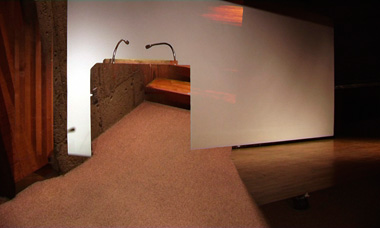 |
| Bernd Behr: Hotel Palindrome (before R.Smithson), 2006, DVD, 9 mins 14 secs; courtesy the artist / Lewis Glucksman Gallery |
Curated by René Zechlin and Matt Packer (Glucksman Curatorial Fellow), Overtake is a group thematic show by a selection of contemporary artists who focus on the practice of appropriation within their work. The term ‘appropriation’ as applied to the artists within this exhibition refers to the borrowing of visual and conceptual components from recent art history to reconstruct these images and ideas to create new art works. The aim of this method of working is less a questioning of ownership or authenticity – a major concern of Appropriation Art in the 1970s and 1980s – but more a reconsideration of art-historical figures, artworks and movements to critically examine and question the assumptions upon which those practices were based. The theories, concepts and ideals surrounding twentieth-century historic work are reconfigured by contemporary artists to position their own work in relation to this artistic lineage.
A juxtaposition of recent historic work and contemporary practice is apparent not only within the works presented in Overtake but also within the wider context in which the exhibition is shown. Overtake runs in conjunction with another exhibition, Gerhard Richter: Survey. Overtake was developed to respond to the selection of Richter works that span a wide range of the artist’s techniques, from the photo-paintings of the 1960s to the abstract paintings of the 1980s and ’90s. Appropriation is a term that moves between the two exhibitions.
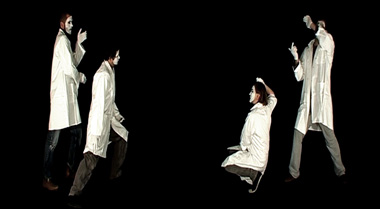 |
| Simon Dybbroe Møller, Pantomima della stella gigante, 2007, video still, DVD, colour, sound, 10:03 min. loop, projection approx. 5,5 x 2 m; courtesy the artist / Galerie Kamm / Lewis Glucksman Gallery |
Richter often borrowed source material from newspaper cuttings and different media to incorporate into his paintings. This is demonstrated in Survey by the piece entitled Hood 1996. Paint is splashed across a black-and-white newspaper clipping of a youth being arrested; the paint obscures the image, interrupting our voyeuristic pleasure. Richter also appropriated many of his own works; this strategy is evident in 128 Photographs from a picture, 1998 . This work is comprised of small photographs abstracted from a large painting entitled Halifax by the artist. The photographic images magnify sections of the original painting, creating a collage or fragmentary composition. The transferral of material from one medium to another and an acute awareness of history are some of the other links forged between this exhibition and its progeny. However, there is only one contemporary work in Overtake that directly references Richter – a film by Jonathan Monk; the other works deal with similar themes but engage with different art-historical figures.
In his film Gerhard Richter Abstraktes Bild 825-11 69 details Insel-Bucherei Nr. 1166 dripping slowly from one page to the next, Monk creates a film sequence using images from an artist book by Richter. The images from the book are distorted, blown-up and superimposed. Tiny details are magnified in a style similar to Richter’s own translation of his painting Halifax to photography. The still images from the book are animated through a process of layering images and fading sequences in and out. The transferal of Richter’s images from the materiality of page to the volatility of projected image breaths life into the stagnant images, yet the fragility of their existence is apparent in the quivering of the image against the drone of an outmoded machine. The projector stands like a sculptural body pointing at a blank gallery wall waiting for its guests to arrive. A push of its button and the colours and textures start to form, one on top of the other like lava they flow.
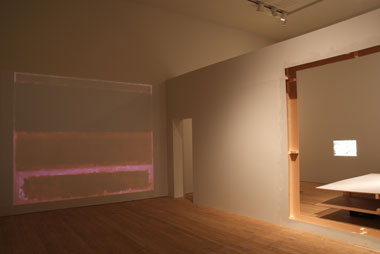 |
| Sisk Gallery with featured artists Bertrand Lavier, Johnathon Monk, and Simon Dybbroe Møller |
Overtake as a multi-media exhibition, in contrast to the more traditional paintings presented in Survey, reflects Richter’s own concern about the process of painting and how it is perceived or translated within a virtual environment of image abstraction and reproduction. Moving between photography and painting, Richter employed techniques such as the blurring of outlines on a painting to give an out-of-focus photographic finish. This experimentation with media and form is taken a step further by the contemporary artists in Overtake.
On walking up the stairs, the first work that captures the eye is Beuys (still a discussion) by Sean Lynch. This piece is an easy introduction to the theme of the exhibition, due to its direct referencing of Joseph Beuys and also due to the work’s direct link with history, the collecting or archiving of documents and their subsequent interpretation. A mixture of fact and phantasm is detected in the information collected about Beuys’ visit to Limerick. The artefacts presented include a black-and-white photograph of Beuys standing in the doorway of the Carnegie library, letters from various sources and a peat-and-butter sculpture. These works by Lynch were previously shown as part of another exhibition entitled Retrieval unit in Limerick City Gallery of Art earlier this year.
 |
| Sean Lynch’s piece Beuys (still a discussion); courtesy Lewis Glucksman Gallery |
Many of the artworks featured in Overtake were already in existence; the participating artists showed them in other contexts or as part of larger individual exhibitions. In this sense, Overtake is comprised of snippets of the selected artist’s work. While this borrowing of work from other contexts ties in well with the exhibition’s main theme of appropriation, it also makes the exhibition more difficult to negotiate for the viewer. The exhibition doesn’t follow a linear progression; spatial, aesthetic and conceptual considerations determine the arrangement of objects and works rather than a chronological order. This positioning of work isn’t problematic in itself, since most of the works were created within a close timeframe and they have a choreography that allows diverse pieces to converse. However, the juxtaposition of different contemporary artists coupled with the referencing of art-historical figures runs the risk of losing the viewer in a myriad of quotations.
While Overtake does require some work on the part of the viewer, the experience of the exhibition is very rewarding when the subtleties of the work begin to reveal themselves. These contemporary international artists and their works were not chosen randomly; the works shown span an array of approaches in dealing with the main themes of the exhibition. Some of the artists focus on the researching, finding and archiving of a recent historic artwork or figure, like Beuys (still a discussion) by Sean Lynch or Trying to find the Spiral Jetty by Tacita Dean – a film tracing the artist’s journey in search of the famous earthwork by Robert Smithson. Other artists take a more subjective approach in positioning their own practice in relation to a specific artistic movement or figure; an example of this approach is Forms & feelings by Falke Pisano.
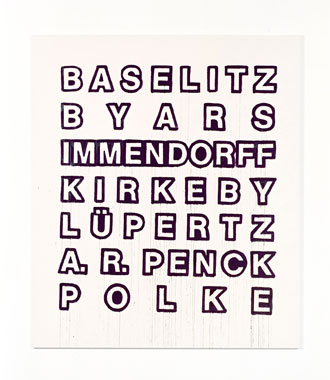 |
| Carsten Fock, Untitled, 2006, acrylic on canvas, 150 x 130 cm, courtesy and copyright Gallery Jan Winkelmann, Berlin; courtesy Lewis Glucksman Gallery |
Forms & feelings is presented as a video work on two synchronised screens. Pisano displays black-and-white images from a photography book of Chillida sculptures by David Finn. These images are layered and dissolve into each other as the artist’s voice is heard commenting on the sculptures. The text is very poetic and the voice hypnotic as the artist contemplates “they do not relate back to me as a spectator, they only provide a presence”. She explores the relationship between herself and the sculptures but also the relationship of the photographer and his daughter – who wrote text to accompany the photographs in the book – to the sculptures. Engaging with the sculptures through photographic reproductions rather than the original forms themselves, Pisano’s work is an investigation of the viewer’s position in a world of image abstraction. The art has become abstract by Tilo Schulz, a large glass wall sculpture stretches across the gallery floor just in front of Pisano’s video work, connecting the two exhibits.
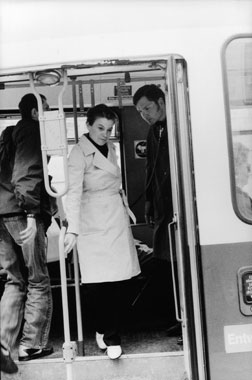 |
| Kerstin Cmelka, Multistability dreamwise, 2006, series of 7 b/w photographs, 96 x 142 cm each; courtesy and copyright the artist / courtesy Lewis Glucksman Gallery |
 |
| Kerstin Cmelka, Multistability dreamwise, 2006, series of 7 b/w photographs, 96 x 142 cm each; courtesy and copyright the artist / courtesy Lewis Glucksman Gallery |
 |
| Gallery One with featured artists Kerstin Cmelka and Tilo Schultz; courtesy Lewis Glucksman Gallery |
The majority of the artworks presented are conceptual in their configuration but the work of Annelies Coste takes a more witty or spontaneous approach in playing with art history. Her work, comprised of small, scribbled sketches – for example, an image of a black banana with ‘ROTTENWARHOL’ written underneath – runs in a haphazard fashion along the stairwell leading from Gallery One up to the Sisk Gallery.
 |
| Annelise Coste, Rottenwarhol, 2007, acrylic and marker on paper, 29.5 x 21 cm, Private Collection, Munich; courtesy Galerie Reinhard Hauff / Lewis Glucksman Gallery |
The Sisk Gallery contains the only work within the exhibition that was made on site. Slap (R. Morris) by Simon Dybbroe Møller, is a large floating slab sculpture made from cutting into the gallery wall partition. Visitors walk through the huge hole in the wall where the material for the sculpture was abstracted. Moller bases this work on slab (platform) by Robert Morris and appropriates the gallery itself in the construction of his work.
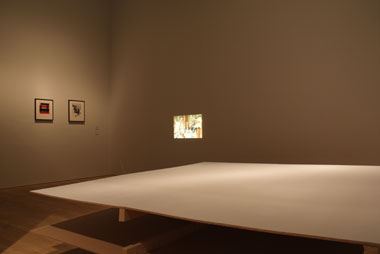 |
| Sisk Gallery featured artist–Wade Guyton, Johnathon Monk, and Simon Dybbroe Møller; courtesy Lewis Glucksman Gallery |
 |
| Sisk Gallery featured artist–Wade Guyton, Johnathon Monk, and Simon Dybbroe Móller; courtesy Lewis Glucksman Gallery |
Other artists exhibiting in Overtake include Bernd Behr, Andrea Büttner, Kerstin Cmelka, Carsten Fock, Iain Forsyth & Jane Pollard, Wade Guyton, Bertrand Lavier, Mark Leckey, and Mario Garcia Torres. Group thematic shows by their very nature present a challenge for the viewer in determining the connection between the selected artists and their work. This is taken a step further in Overtake as the exhibition was formed not only to respond to Richter – a very established and prolific artist in his own right – but also to engage with art history in a more general sense. The viewer in some cases is twice removed from the work as knowledge is required not only of the contemporary artist but also of the historic work they are referencing. To make the exhibition more accessible, an informational video featuring an interview with René and Matt is available for viewing and sums up the main themes of the exhibition. This interview with the two curators works well as an educational tool in giving an overview of the show, but the video monitor and accompanying headphones hover awkwardly on the boundary of the main exhibition space. Uncertainty about the status of the video as informational tool or art object is created. An exhibition Almanac is available for a small fee and this provides important reference material to the exhibition also.
 |
| Andrea Büttner, Shame in Venice, 2005 (detail), photocopies, colour pen, woodcut, printing plate, mirror, dimensions variable; courtesy and copyright: Andrea Büttner and Hollybush Gardens, London; courtesy Lewis Glucksman Gallery |
While there is a lot to be taken in between the two exhibitions, the juxtaposition of Survey and Overtake enables an exploration of the influence of Richter on a younger generation of artists and highlights the significance of art history in the production of contemporary art. Survey becomes the foundation or trace history from which the contemporary exhibition emerges. Overtake is weaved together like a delicate tapestry, each thread strategically placed to complement the overall design, yet it requires some digging on the part of the viewer to decipher the pattern. A fusion of diverse artists and histories, Overtake is well positioned within the Glucksman – a university gallery – to challenge our observational and inquisitive faculties, in presenting an exhibition full of subtle associations.
Elaine O’ Sullivan is a freelance writer on visual and performance art, currently working as Writer In Residence for Cork Art Trail.